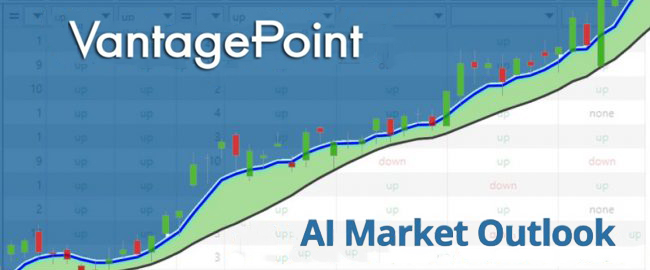There has been an endless economic battle occurring for millennia. This war engulfs the world and is engaged in by every government against its citizens. That may sound like a harsh and very politically biased statement, but the stats and facts don’t lie. This war in its most concise form is called currency debasement. Currency debasement refers to the deliberate or unintentional reduction in the value or purchasing power of a currency over time. It typically occurs when a government or central bank takes actions that lead to an increase in the money supply, causing inflation and eroding the value of the currency. This can result from factors such as excessive printing of money, economic mismanagement, or loss of confidence in the currency. Currency debasement effectively diminishes the worth of money and negatively impacts individuals, businesses, and the overall economy.
The crux of this conflict lies in the redistribution of economic energy, commonly known as wealth. All the money and power in the world are embroiled in this war, and it leads us to ponder how wealth is continually reshuffled as well as who wins and who loses.
Individuals can use several indicators to assess whether currency debasement is occurring. Here are a few commonly used measures:
1. Inflation Rate: Monitoring the inflation rate provides insights into the general increase in prices over time. Higher inflation rates indicate a loss of purchasing power and currency debasement.
2. Consumer Price Index (CPI): The CPI tracks the average price changes for a basket of goods and services commonly purchased by households. Rising CPI indicates inflationary pressures and potential currency debasement.
3. Exchange Rates: Monitoring the exchange rate of a currency against other currencies can reveal fluctuations and devaluation. A significant decline in the exchange rate suggests currency debasement relative to other currencies.
4. Asset Prices: Observing the prices of assets, such as real estate, stocks, or commodities, can provide indications of currency debasement. If these prices experience rapid and sustained increases, it may reflect the devaluation of the currency.
5. Historical Data: Comparing the current value of goods, services, or investments to historical data can reveal long-term trends of currency debasement. Significant price increases over time may suggest a loss in the currency’s purchasing power.
While economists would like you to think that measuring currency debasement is very complicated it all boils down to having a clear understanding of three words, “LESS”, “SAME”, and “MORE.” Any individual can quickly and easily determine whether their unit of currency is buying less of something else, the same as something else or more of something else. The stats for currency debasement in the United are horrific. The chart below shows that since 1913 when the Federal Reserve Act was passed that the U.S. Dollar has lost 98% of its purchasing power.
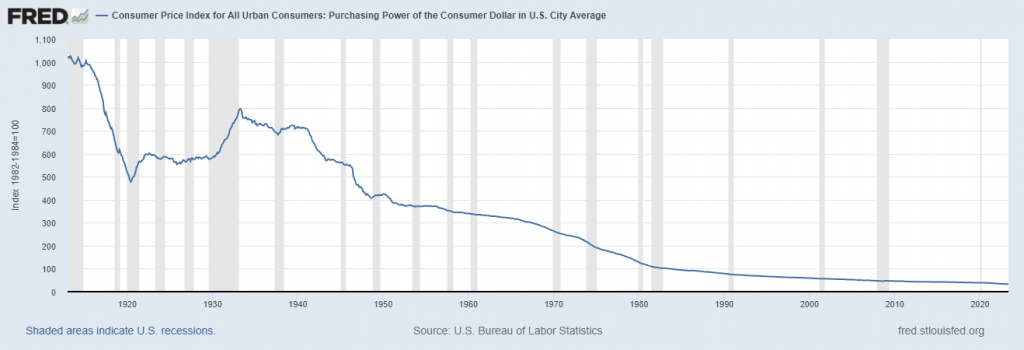
There are three primary drivers behind this ongoing economic war. Firstly, government policies wield considerable influence as the most potent actors in this struggle. Governments worldwide manipulate money, or economic energy, to redistribute it according to their agenda. Secondly, technology plays a pivotal role in this economic warfare. The advent of innovations like Apple, Google, Tesla, and artificial intelligence has significantly impacted the balance of power. Lastly, hard work is another critical driver in this economic battle. The toil, competition, and energy exerted by individuals as they rise each morning to pursue their endeavors contribute to the redistribution of wealth.
However, it’s disheartening to acknowledge that governments hold a magnitude of power in this war that surpasses that of technology, and technology, in turn, surpasses the power of individual labor. This is evident when one considers the limitations of hard work alone. No matter how arduously you work, without access to machines or computers, there is a finite limit to what you can achieve. This underscores the importance of considering government policies and technology if one hopes to survive and thrive in this world.
The world’s reserve currency, the U.S. dollar, is currently undergoing a collapse in value against various assets such as the S&P index, real estate, gold, and art. This realization is sobering indeed. If we had sound money, the dollar wouldn’t face such a decline.
According to government statistics, $1 in 1913 is the equivalent in purchasing power to about $30.72 today, an increase of $29.72 over the last 110 years. Over these last 110 years, the dollar had an average inflation rate of 3.16% per year producing a cumulative price increase of 2,971%. What makes these numbers horrifying is that these metrics are comparing the value of the U.S. dollar against basic, mass-produced consumer goods.
It’s essential to note that consumer goods encompass items produced on assembly lines, such as candy bars, water bottles, and everyday widgets. These goods are the cheapest and least scarce items in our civilization. What makes this situation so toxic is that not one in a million individuals will notice it. The introduction of technology into an ecosystem reduces costs through automation, efficiency, and streamlined processes, while also increasing productivity by enabling timesaving, improved communication, and data-driven decision-making. This leads to enhanced operational efficiency, resource utilization, and adaptability, ultimately contributing to improved business performance.
When basic everyday consumer widgets increase in price, even with the introduction of technology into an ecosystem you can rest assured that the currency debasement is worsening the value of the currency faster than the technology is improving productivity and efficiency.
What everyone is most concerned about is the purchasing power their money holds. While money, in its simplest form, is a medium of exchange, it also is what allows people to trade goods and services. It is a universally accepted intermediary that eliminates the need for a coincidence of wants, which is required in a barter system. Money serves several key functions: it acts as a medium of exchange, a unit of account, a store of value, and occasionally, a standard of deferred payment.
The concept of money has evolved significantly over time, from commodity money like gold and silver coins to paper money, and now to digital forms of money like cryptocurrencies. Each form of money has its advantages and disadvantages, and the ‘ideal’ form of money can vary depending on the specific needs and circumstances of an economy.
However, the ideal form of money generally possesses certain characteristics. It should be durable, meaning it can withstand repeated use; divisible, so it can be broken down into smaller units; portable, allowing it to be carried around and used for transactions; uniform, so each unit is identical to every other unit; limited in supply to maintain its value; and acceptable, meaning everyone must be able to use it for transactions and lastly uncensorable, meaning that no one can revoke your ability to transact with it.
In the modern world, digital currencies, particularly cryptocurrencies like Bitcoin, are often touted as the ‘ideal’ form of money. They are durable, as they exist on a decentralized digital ledger called a blockchain; divisible, as one Bitcoin can be divided down to eight decimal places; and portable, as they can be sent anywhere in the world with an internet connection. They are also uniform, as each Bitcoin is identical to every other Bitcoin; limited in supply, as there will only ever be 21 million Bitcoins; and increasingly acceptable, as more businesses start to accept Bitcoin as a form of payment.
All assets can act as money substitutes. Meaning that while they may not meet all the qualities mentioned above, they are convertible into other forms of assets that people often find highly desirable.
Here is a listing of the major asset classes in the world along with the current market caps. Regardless of who you are, and how you are trying to protect your wealth if you are playing the game with FIAT currency, the wealthy have learned that you move out of FIAT and into one of these asset classes to protect your assets.
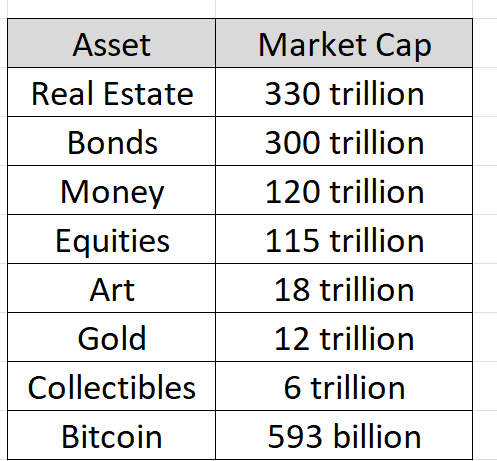
Now, let’s step outside of America and explore other countries where foreign currencies are collapsing against the dollar.
The Argentine peso has lost 99% of its value against the dollar in the last 22 years.
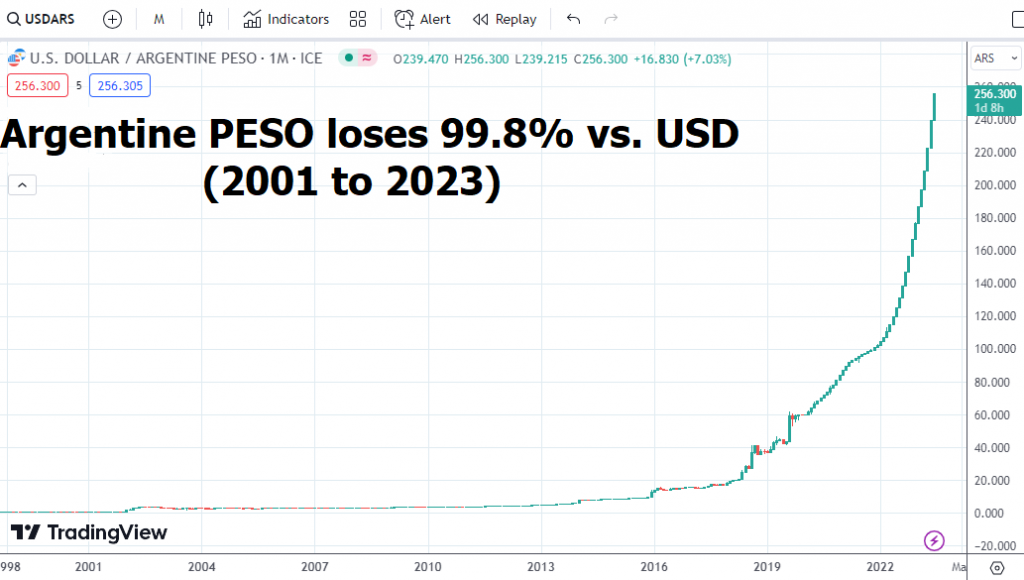
Similarly, the Turkish lira has lost 96% of its value in the same period.
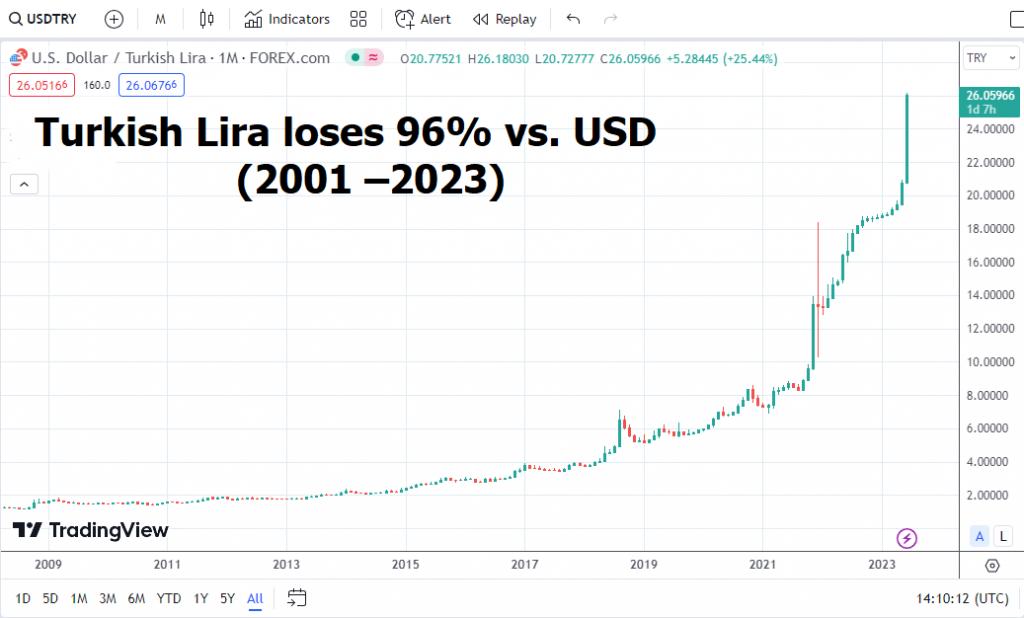
What is important to note when this occurs is that businesses and citizens trying to survive in this environment have only one option, to stop transacting in the weak currency and to substitute something stronger. For example, when a currency loses 96% what this effectively means is that a business needs to produce 25 times more over the same time period just to stand still. It is horrifying to contemplate.
Here are the performance metrics for the Indian Rupee:
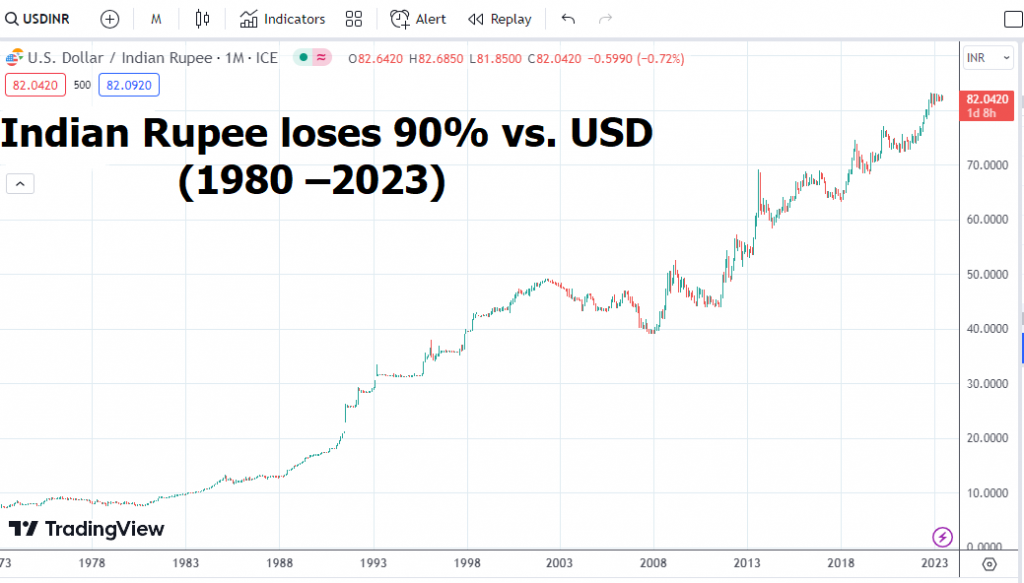
The Pakistani Rupee:
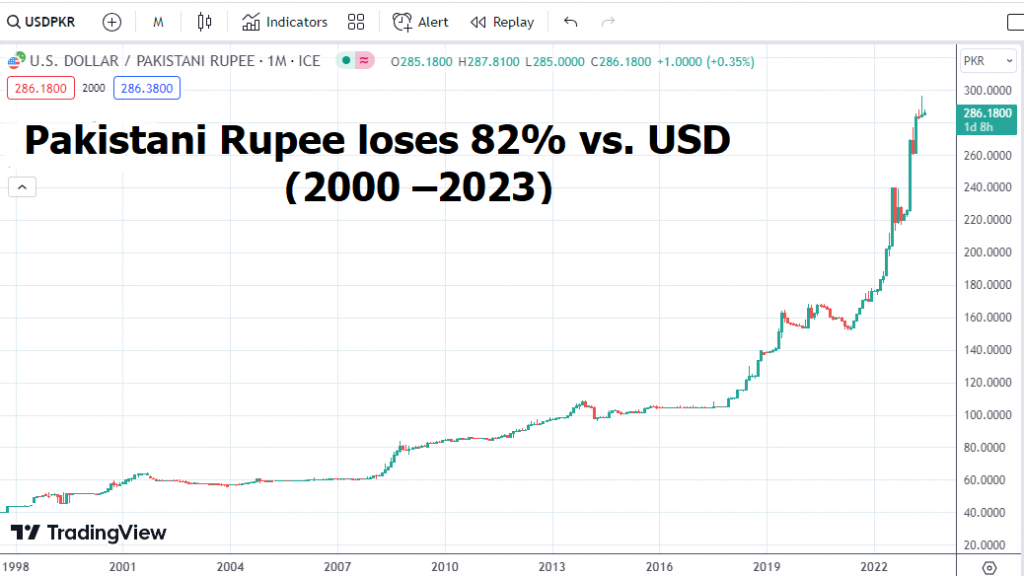
And lastly the Brazilian Real.
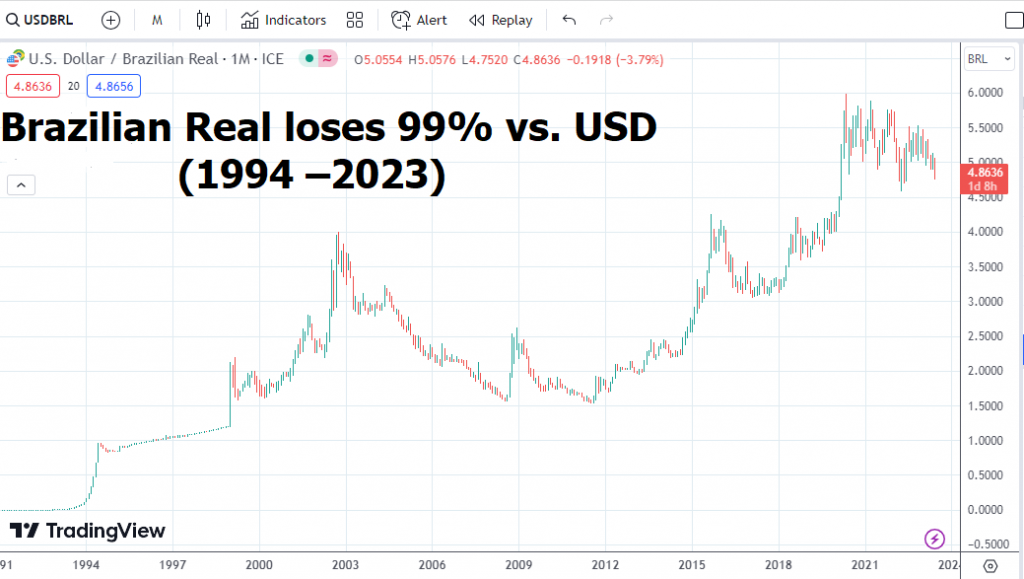
Keep in mind that these valuations are based upon a comparison to the U.S. Dollar which is the world’s reserve currency. These fiat currencies are worthless when compared to anything that resembles a real asset.
The situation is dire indeed.
If we zoom out and look at the world by simply looking at the top ten countries that are being hit heavily by inflation now you can imagine the battles, they are facing trying to maintain value when being forced to transact in a currency that is perpetually being debased.
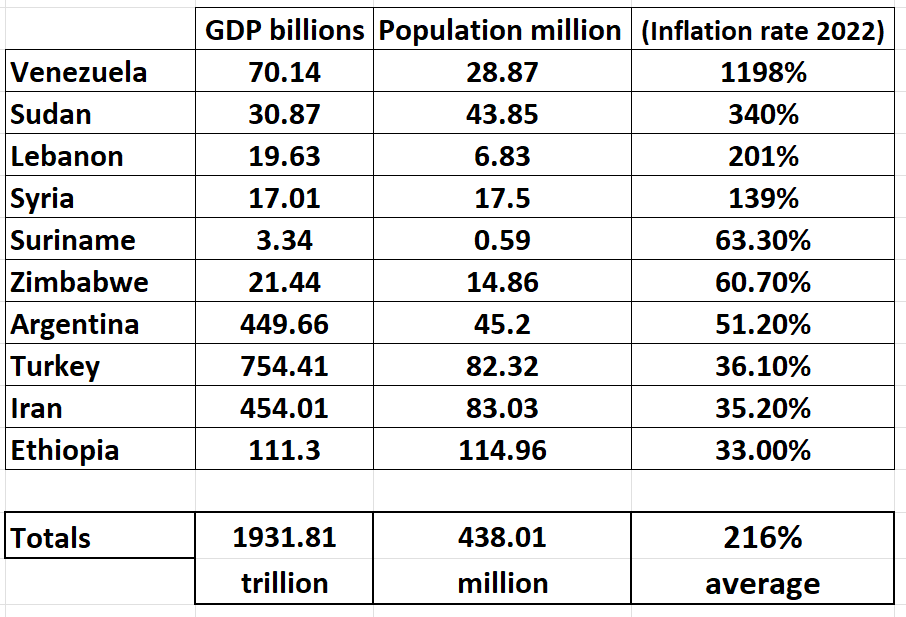
This graphic shows that roughly 5% of the earth’s population of 438 million people produces $1.931 trillion in GDP in an economic environment that is substandard because the value of their wealth is being confiscated completely by the FIAT standard the unit of currency, they are transacting in.
To preserve your wealth, you may consider converting your currency into a scarce, desirable, portable, durable, and maintainable asset. There are certain assets that possess scarcity and desirability, such as beachfront property. However, they lack portability and maintainability. Owning a million dollars of property, for example, comes with the burden of hefty annual maintenance costs and increasing property taxes, making it challenging to sustain over time.
Stocks over the last 100 years as measured by the S&P 500 index have averaged a 10% average annual growth rate (if you pick the highest quality companies.) This is against the backdrop in the United States where Money supply growth has averaged over 6 ½% per year over the last 100 years.
The challenge associated with stocks is that 99% of the stock market does not keep pace with the rate of inflation. Companies like Apple, Google, Tesla, Microsoft and Nvidia have over the last decade. In The 1970’s, there was an index of stocks called the Nifty Fifty which were the top blue-chip performers. Today we have the FAANG and MATANA stocks. It is pure speculation to what will replace the FAANG or MATANA stocks and a full-time endeavor to try to stay abreast of this.
So, what is the best strategy for preserving wealth? There’s only one winning strategy that I see: holding the best money. If you hold onto the dollar, the best currency, you’re essentially heading toward zero. Weaker currencies are also destined for value erosion in just a few years. This is not an opinion. All fiat currencies eventually go to a value of zero. History makes this point very clearly. The key is to hold the best money, and that is where Bitcoin comes into play.
Bitcoin transcends the limitations of traditional assets and currencies.It replaces management with cybernetic control, eliminating the dilution caused by human decision-making. It replaces labor with a digital system, removing the risks associated with rising labor costs. It eliminates competition, as there is only one Bitcoin, making it immune to technological disruptions. Bitcoin is an incorruptible and global digital asset. And most importantly, even with its massive volatility, it has been the #1 performing asset of all time in its short 14-year life cycle. This is primarily because there will only ever exist 21 million Bitcoin so there is tremendous scarcity.
Over the past month, there have been huge developments in the Bitcoin space. Several major financial institutions across the globe have submitted applications to their respective country’s regulators, seeking approval to custody Bitcoin for their customers. In Spain, this includes prominent banks such as Banco Santander, BBVA, and Caixa Bank. Germany’s Deutsche Bank, Commerzbank, and KfW have also applied. In France, BNP Paribas, Crédit Agricole, and Société Générale are seeking regulatory approval for Bitcoin custody. Finally, in Hong Kong, HSBC, Bank of China (Hong Kong), and Hang Seng Bank have joined the trend. These applications signify a growing institutional interest in providing cryptocurrency services.
Echoing BlackRock’s initiative, a surge of both conventional and cryptocurrency asset managers are making moves in the Bitcoin ETF space. Firms such as Fidelity Investments, Ark Investment Management, Invesco, WisdomTree, Bitwise Asset Management, and Valkyrie have recently updated or revived their applications for spot Bitcoin ETFs. The green light for such an ETF would be a landmark achievement for the sector, broadening institutional access to Bitcoin and enabling investors to trade the cryptocurrency with the same ease as traditional stocks. However, this convenience comes with a trade-off, as it may compromise some inherent characteristics of Bitcoin.
However, this pales in comparison to the reality that the largest financial institutions in the world are all also vying to introduce a bitcoin ETF into the financial ecosystem of the United States. The approval of a Bitcoin ETF by the U.S. SEC would increase Bitcoin’s accessibility and liquidity, as ETFs are traded on traditional stock exchanges and are available to a wide range of investors. This approval would also lend regulatory legitimacy to Bitcoin, potentially boosting its acceptance and demand. Investors could gain exposure to Bitcoin without managing the risks of storing and securing the digital asset themselves, offering a new avenue for portfolio diversification. However, this could also lead to increased regulatory scrutiny and does not provide the same control as owning Bitcoin directly.
Many of these companies over the last 14 years have not been advocates of Bitcoin. It would be fair to say that many of them have been enemies. But for reasons left to a trader’s imagination, they have now had a change of heart in recognizing that Bitcoin is the most pristine and valuable asset in a digital age. Bitcoin’s uniqueness lies in its finite supply, capped at 21 million, and its blockchain technology, which ensures transaction transparency and security, its use as an inflation hedge, and its future potential to disrupt traditional financial systems, along with the reality that its network is incorruptible and available to anyone in the world with a simple internet connection. Bitcoin’s rise as a non-sovereign store of value continues to have profound geopolitical consequences, where advocates state that it will lead to a global non-inflationary reserve currency.
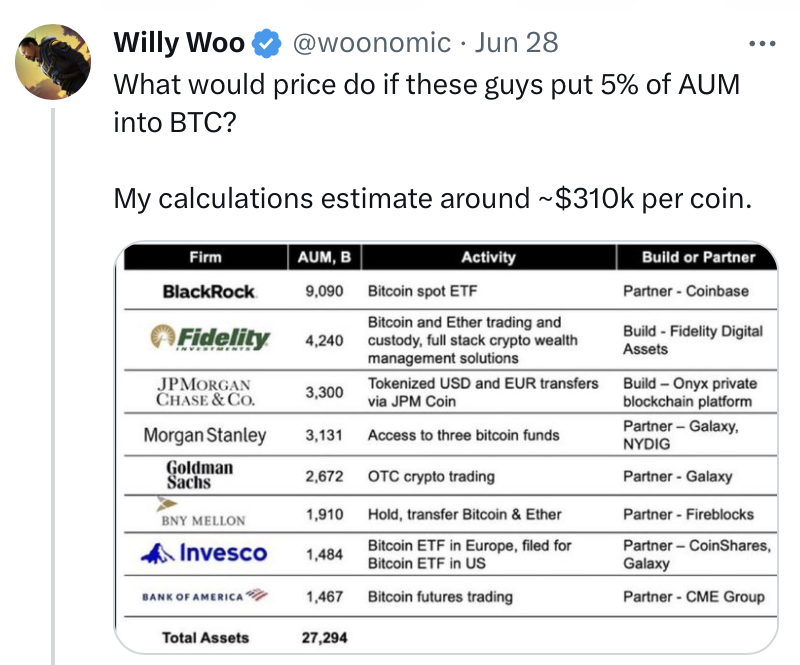
These companies control $27.294 trillion in assets. They all have very tiny exposure to bitcoin at present. The question was posed online that what would happen to the price of bitcoin if these companies simply moved 5% of their assets under management to bitcoin over the next few years. The answer provided by Cryptocurrency analyst Willie Woo, is that Bitcoin would rise in price to $310,000 per bitcoin.
While this certainly is exciting to bitcoiners, it pales in comparison to the perspective that Bitcoin Maximalists entertain that bitcoin will eventually attract a large percentage of wealth that is currently trapped in other asset classes. Assuming that only a 5% transfer from other asset classes into bitcoin is displayed in the following graphic.
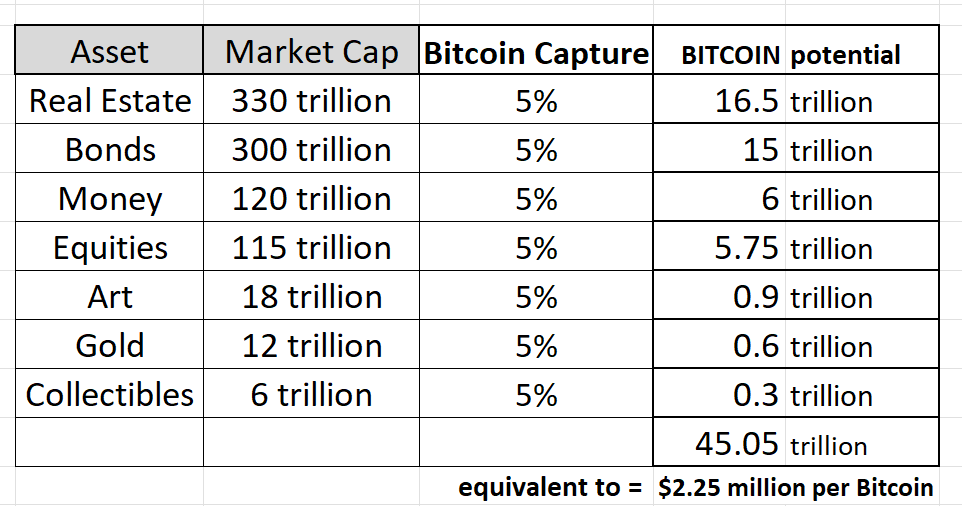
The market cap of all asset classes in the world is roughly $900 trillion. If only 5% of that value moved into bitcoin because of its unique, modern day qualities, bitcoins market cap would jump to $45 trillion or roughly $2.25 million dollars per bitcoin. This may sound like pie in the sky to non-believers. But to anyone who is serious about wealth preservation, the bitcoin promise is one of eliminating the inflationary decimation that has plagued humanity since the beginning of time. Bitcoin, as a decentralized digital currency, offers a unique alternative to traditional financial systems by eliminating the need for intermediaries and providing a level of pseudonymity for users. Its finite supply, like precious metals like gold, creates an inherent scarcity that can potentially drive its value. The currency’s divisibility, portability, and immutability make it a versatile and secure medium of exchange, capable of facilitating micro-transactions and irreversible transfers. With its open-source nature and programmability, Bitcoin fosters transparency and innovation, paving the way for advanced financial applications such as smart contracts.
Here are the facts:
There is not one country in the world whose fiat currency has kept pace with inflation.
99% of all companies that are listed on the world stock markets are incapable of keeping pace with inflation.
Adding insult to injury, does anyone expect the Federal Reserve, who has destroyed purchasing power by 98% over the last 110 years all of a sudden to change its inflationary policies and behaviors?
The majority of assets do not keep pace with the rate of inflation, or the growth of the money supply.
Over the last 3 years, the money supply has grown by roughly 36%.
The S&P 500 is up 35.7%
Gold is DOWN 3.3% over the same time frame.
Treasury Bonds are DOWN 19.87%.
Residential property prices will vary from city to city, but they are up roughly 35% over the last 2 years and have started to decline.
Meanwhile, bitcoin is UP 162% during the same time frame.
When bitcoin advocates ponder these performance metrics, they are reminded of the warning posted on the Genesis block of the bitcoin blockchain by its creator. Satoshi Nakamoto, the pseudonymous creator of Bitcoin, embedded a message in the first block of the Bitcoin blockchain, known as the Genesis Block or Block 0. This message is a timestamp and reads:
“The Times 03/Jan/2009 Chancellor on brink of second bailout for banks”
This message is believed to serve two purposes:
1. It acts as a timestamp, proving that the Genesis Block was created on or after January 3, 2009, the date of the headline.
2. It is seen as a comment on the instability of the traditional banking system and its inherent inflationary nature. The headline is from The Times newspaper and refers to the UK government’s consideration of a second bailout for banks during the 2008 financial crisis. This suggests one of the motivations behind the creation of Bitcoin was to create a financial system that doesn’t rely on trust in centralized banks and governments to create financial health or well-being for a civilization.
The economic war continues whether or not you believe in the qualities that bitcoin offers. The challenge as a consumer is always trying to determine what is the best move forward.
Can we trust the government to keep inflation at bay? I’ll be convinced when I see it with my own eyes. We’re talking about trillions of dollars, conjured from nothingness.
In the past three years alone, government debt has skyrocketed by a staggering $8.2 trillion. Yet, our GDP is limping along at less than 60% of that speed. That’s hardly the picture of a thriving economy.
So, what does this mean for you, the savvy trader?
How have you been feeling about your portfolio’s performance lately? Are you at ease in an economic climate where the go-to solution for every problem is to print more money, only to be left scratching our heads when inflation skyrockets?
And how does your investment strategy stack up against the precision of artificial intelligence?
In the not-so-distant future, AI will be your doctor, your chauffeur, your children’s teacher, and yes, your investment advisor.
For over four decades, we at Vantage Point have been laser-focused on providing traders with the cutting-edge technology of machine learning, neural networks, and artificial intelligence.
We’re navigating uncharted waters here.
As a trader, your primary concern is being on the right side of the right market at the right time. And that means leveraging the power of VantagePoint’s artificial intelligence. Everything else is just background noise.
The race to devalue our currency is a harsh reality. This economic climate is pushing traders into tighter time frames as everyone scrambles for yield.
As this mad dash for yield intensifies, real asset prices will continue to climb, and our economy will remain hooked on a disastrous monetary stimulus.
Do you have the tools and the know-how to spot the strongest trends at the perfect moment in this economic climate? What’s your strategy for preserving your purchasing power as this trend picks up speed?
I invite you to join us at one of our free live Master Classes, where we’ll show you how artificial intelligence is the only way to stay consistently ahead of the curve when it comes to risk and reward opportunities in this environment.
In the interim, I also advise you to thoroughly study the Bitcoin ecosystem.
Visit With US and check out the a.i. at our Next Live Training.
THERE IS A SUBSTANTIAL RISK OF LOSS ASSOCIATED WITH TRADING. ONLY RISK CAPITAL SHOULD BE USED TO TRADE. TRADING STOCKS, FUTURES, OPTIONS, FOREX, AND ETFs IS NOT SUITABLE FOR EVERYONE.IMPORTANT NOTICE!
DISCLAIMER: STOCKS, FUTURES, OPTIONS, ETFs AND CURRENCY TRADING ALL HAVE LARGE POTENTIAL REWARDS, BUT THEY ALSO HAVE LARGE POTENTIAL RISK. YOU MUST BE AWARE OF THE RISKS AND BE WILLING TO ACCEPT THEM IN ORDER TO INVEST IN THESE MARKETS. DON’T TRADE WITH MONEY YOU CAN’T AFFORD TO LOSE. THIS ARTICLE AND WEBSITE IS NEITHER A SOLICITATION NOR AN OFFER TO BUY/SELL FUTURES, OPTIONS, STOCKS, OR CURRENCIES. NO REPRESENTATION IS BEING MADE THAT ANY ACCOUNT WILL OR IS LIKELY TO ACHIEVE PROFITS OR LOSSES SIMILAR TO THOSE DISCUSSED ON THIS ARTICLE OR WEBSITE. THE PAST PERFORMANCE OF ANY TRADING SYSTEM OR METHODOLOGY IS NOT NECESSARILY INDICATIVE OF FUTURE RESULTS. CFTC RULE 4.41 – HYPOTHETICAL OR SIMULATED PERFORMANCE RESULTS HAVE CERTAIN LIMITATIONS. UNLIKE AN ACTUAL PERFORMANCE RECORD, SIMULATED RESULTS DO NOT REPRESENT ACTUAL TRADING. ALSO, SINCE THE TRADES HAVE NOT BEEN EXECUTED, THE RESULTS MAY HAVE UNDER-OR-OVER COMPENSATED FOR THE IMPACT, IF ANY, OF CERTAIN MARKET FACTORS, SUCH AS LACK OF LIQUIDITY. SIMULATED TRADING PROGRAMS IN GENERAL ARE ALSO SUBJECT TO THE FACT THAT THEY ARE DESIGNED WITH THE BENEFIT OF HINDSIGHT. NO REPRESENTATION IS BEING MADE THAT ANY ACCOUNT WILL OR IS LIKELY TO ACHIEVE PROFIT OR LOSSES SIMILAR TO THOSE SHOWN.








